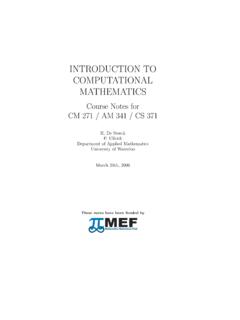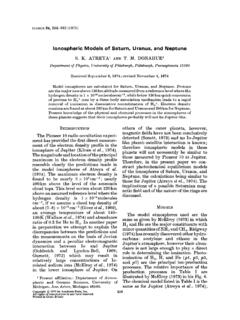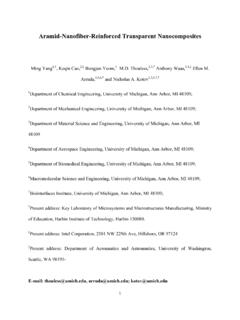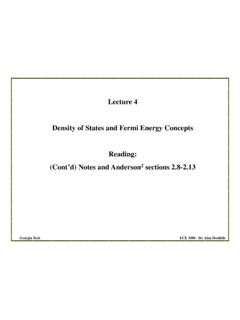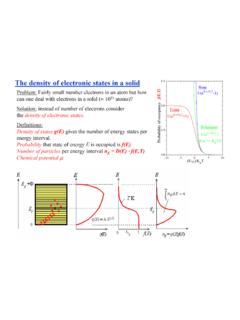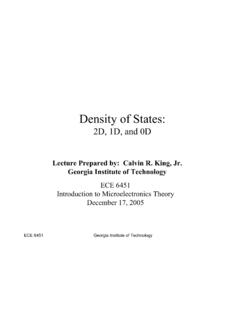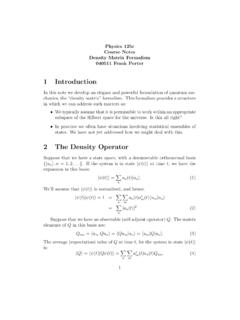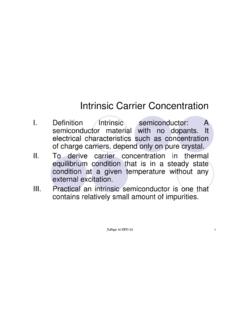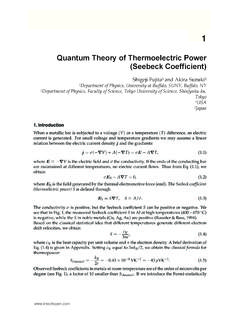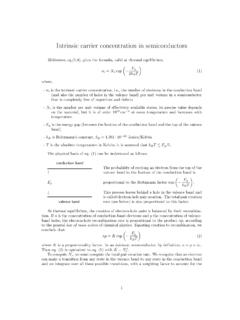Transcription of Thermal properties of phonons - U-M Personal World Wide ...
1 5 Thermal properties of phononsRef. Chapter 5Q1: Why do most solids become larger as we increase the temperature?Q2: Why is foam a good Thermal insulator?Q3: Why is metal cold to touch? BackgroundHere we review some basic ideas of quantum mechanics, thermodynamics and statistical physics, which will be used in this What are phonons ?Quantum Mechanics tells us that waves are particles. Energy E= and momentum P= kSo elastic waves (sound waves) are particles too, and these particles are called phonons . The energy of a phonon E= The momentum of a phone P= What is temperature?The rigorous definition of temperature requires knowledge on thermodynamics and Thermal equilibrium (which are discussed in Physics 460).Roughly speaking, the temperature HTL measures how widely the particles are moving in a higher T, atoms move more widely.
2 At lower T, atoms don t want to move elastic waves, this means that at higher T, the amplitude of sound waves are larger (more phonons ). At lower T, the amplitude is smaller (lessphonons). We have more phonons at high T and less phonons at low Planck distribution: how many phonons do we have?In a solid, there are many different sound waves (with different wavelength and frequencies). In this section, we pick one of these waves (withfixed wavevector and frequency) and try to understand this single mode first. Then, in the next section, we will consider all different modes andadd their contributions together. number of phonons (fixed frequency )The number of phonon is not a fixed value. If an atom start to oscillate, then we created some phonons . If the oscillation stops, the phononsdisappear.
3 Although we cannot determine the number of phonons , at a fixed temperature we know the probably of having n phonons . Let's consider a sound wave with a fixed wavevector k and a fixed frequency and ask how many phonons we will have in this wave. Theprobably of having n phonons here 19( )PHnL exp-EnkBTHere kB= 10-23J K is the Boltzmann constant (which is one fundamental physics constant) and T is absolute temperature. (0K=-273Co). En is the energy carried by these n phonons . Because each phonon carries energy , En=n . So,( )PHnL=1 Zexp-n kBTHere Z is the normalization factor (which is called the partition function). This expJEkBTN is known as the Boltzmann factor, which is one fundamental assumption in statistical physics. Here, we will not try to prove thisprobability.
4 Instead, we will use it as granted (details can be found in Physics 460).Q: What is this normalization factor Z?A: Total probability is 1. We can use this condition to fix Z.( )1= n=0 PHnL= n=0 1 Zexp-n kBT=1Z n=0 exp-n kBT=1Z11-expJ- kBTNHere we used the fact that 1+x+x2+x3+..=11-xSo we have( )Z=11-expJ- kBTNA verage number of phonons ( )Xn\= n=0 nPHnL= n=0 nZexp-n kBT=1Z n=0 nexp-n kBT=1 ZkBT n=0 exp-n kBT=-1 ZkBT n=0 exp-n kBT=-1 ZkBT 11-expJ- kBTN=1 ZkBT 11-expJ- kBTN2exp- kBT kBT=expJ- kBTN1-expJ- kBTN=1expJ kBTN-1 The average phonon number depends on temperature T, the frequency of the phonons and some fundamental physics constants and kB.( )Xn\=1expJ kBTN-1 This relation is known as the Planck distribution or the Bose-Einstein [89]:=PlotB:1 Exp@xD-1>,8x,0,3<,PlotRange 880,3<,80,10<<,PlotStyle Thick,AxesLabel :" kBT ","Xn\">,LabelStyle MediumFOut[89]= kBT 246810Xn\At a fixed temperature T, low frequency modes have much more phonons than high frequency modes.
5 The phonons with <kBT . the numberof phonon modes at >kBT is very low. So at very low temperature, we only need to consider acoustic [94]:=PlotB:1 Exp@1 xD-1>,8x,0,3<,PlotRange 880,3<,80,3<<,PlotStyle Thick,AxesLabel :"T kB","Xn\">,LabelStyle MediumFOut[94]= \For a fixed frequency, the number of phonons reduce as T goes down. At high T,( )Xn\=1expJ kBTN-1 kB T-12At low T,( )Xn\=1expJ kBTN-1 exp- Energy carried by phonons (fixed frequency )One phonon has energy , so the average energy carried by these sound waves are( )XE\=Xn\ = Xn\= expJ History of the Planck distribution or the Bose-Einstein distribution was firstly discovered by Planck in the study of black-body radiation. There, Planck studies the energy carried by light, which isanother type of wave (electromagnetic waves) very similar to sound waves.
6 At that time, before the quantum mechanics is established, peopleconsider light as classical waves. If one assumes that light is a classical wave, one find that the energy carried by these waves (light) is infinite atany temperature, which is obviously wrong. This infinite energy problem is known as the ultraviolet catastrophe. Eventually, it is Planck whopointed out that if we view light as particles (photons) with each particle carrying energy , then all the problems are solve. This discovery, aswell as many other progresses, eventually led to the discovery of the quantum fact, the distribution Planck discovered is valid for any waves, not limited to light. For sound waves and phonons , the same physics law appliesand the number of phonons follow exactly the same distribution.
7 ( )Xn\=1expJ kBTN-1 Later, Bose and Einstein discovered that for any bosonic particles, the average number of particles is( )Xn\=1expJ - kBTN-1where is the energy of this particle and is the chemical potential. The Planck distribution is a special case of the Bose-Einstein distribution,where is 0.(Photons and phonons are both bosonic particles (bosons), so they obey the Bose-Einstein distribution.) Total number of phonon modes, total energy and heat capacityIn the last section, we proved that for a sound mode with frequency , the energy carried by this sound wave is XE \= expJ kBTN-1In a solid, there are many different sound modes (with different frequencies). What is the total energy carried by all these sound modes?( )E= iXE i\where i sums over all the different phonon modes.
8 This sum can be rewrite in terms of an integral over frequency density of states (DOS)The density of states (DOS) is a function of frequency , which measure the number of sound modes per interval of frequency (or energy).The number of states (modes) in the frequency range between and + is:( ) N=DH L where DH L is the number of phonon modes:( )N= 0 N= 0 DH L We can separate DH L into the sum of DpH L22 ( )DH L= pDpH L=DLAH L+DLTH L+..where p indicates different phonon branches (also known as polarizations). Total number of phonon modesQ: How many different phonon modes we have?A: The total number of phonon modes in one branch (LA, LO, ..) coincides with the number of unit does the total number of phonons coincides with the number of unit cells?Let s use a simple example to demonstrate this.
9 Consider a 1D chain of atoms (assuming that there is one atom per unit cell). The atoms arelabeled by an integer s=1,2, Periodic boundary conditionSound waves on this lattice can be written as( )us=AexpH- tLexpH kasLwhere us is the deformation of the site s, A is the amplitude, is the frequency, k is the wavevector and a is the lattice boundary condition means us=us+N( )us+N=AexpH- tLexp@ kaHs+NLD=AexpH- tLexpH kasLexpH kaNL=usexpH kaNLTherefore, expH kaNL=1, so kaN=2 n where n is an integer. So( )k=2 naN=2 nLwere, aN=L is just the length of the system. Notice here that k and k+2 a gives exactly the same wave, ( )expB k+2 aasF=expH kas+ 2 sL=expH kasLexpH 2 sL=expH kasLSo we will only need to consider - a<k , all the possible values of k are( )k=0, 2 L, 4 L, 6 LThere are N possible values of k, so we have N phonon modes.
10 This number N is the number of unit relation and the Thermal dynamic limitQ: In the k-space, how far is the separation between two allowed phonon modes?A: 2 /L, since k=2 n LThis result can also be understood using the uncertainty relation. For a system with size L, phonons are confined in the real space, so we know theposition of the phonon with uncertainty L. Quantum mechanics tells us that if we know the position with uncertainty L, the uncertainty of momen-tum DP shall be 2 L. So each quantum state will occupy a region of 2 L in the momentum space. We also know that the momentum P andthe wave-vector k are the same quantity, up to a factor of . So this means that in the k-space, each phonon mode shall occupy a region with size2 /L. In other words, two phonon modes will be separated by 2 the Thermal dynamic limit ( L ), the spacing between two phonon modes 2 L 0, so we can treat the momentum k as a boundary condition (see our textbook)Total number of phonons in a d-dimensional a d-dimensional crystal with n atoms per cell, there will be dn phonon modes @d acoustic and dHn-1L optical].




